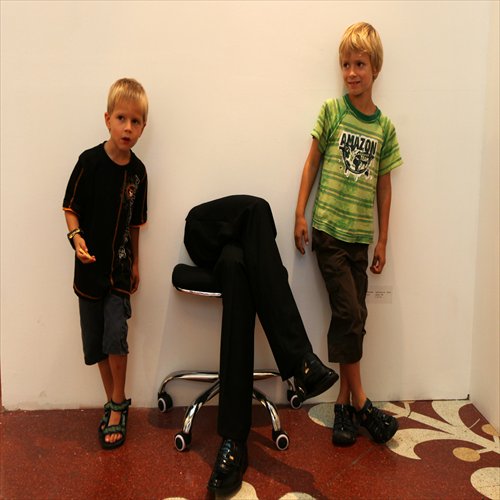SH Contemporary wraps up

Shanghai's sixth annual art fair draws diverse crowd, few buyers
In China's art circle, the annual SH Contemporary has played an integral role in bringing art and collectors together. The sixth SH Contemporary, which wrapped up on Sunday, saw about 90 galleries from 18 countries participating in the three-day event held at the Shanghai Exhibition Center.
According to the organizer of SH Contemporary, the fair attracted about 600 collectors from all over the world and over 35,000 visitors.
"We had a good fair. Chinese galleries did better than foreign galleries, but most of the dealers coming from abroad understand that to grab the attention from Chinese collectors, they need time. Many were happy to start a conversation with the Chinese art world nevertheless," Massimo Torrigiani, artistic director of the SH Contemporary 2012, told the Global Times.
International event
The business side of buying and collecting art remains a top concern for participating galleries at the fair. Statistical figure of this year's trade have not been released.
However, according to organizers, sales have been completed with foreign artists such as Alighiero Boetti and Francesco Clemente (Italy), Araki Nabuyoshi and Yayoi Kusama (Japan), Carsten Nicolai (Germany) and Halim Al Karim (Iraq), as well as Chinese contemporary artists such as Ding Yi, Zhu Dequn, Zhang Enli.
Developed in conjunction with a curatorial network, Arthub Asia, the fair featured various projects separated by categories: Now Ink (ink painting and calligraphy), Hot Spots (large scale, site specific projects and on-site performances), First Issues (young artists), The Video Room (moving image and new media) and the Asia Pacific Photography Prize, the latter which featured winner Wen Ling, represented by Star Gallery, Beijing.
Along with the exhibitions, a series of panels and forums featuring artists, directors and curators were held.
Window shopping
"As I observed, the overall quality of participating galleries was better than that of last year. More quality overseas galleries came this year," Ronald Kiwitt, director of Other Gallery, told the Global Times.
"Since we are a local gallery, it's good PR for us to be in the SH Contemporary. It doesn't matter whether we sell art here. It's important to bring more visitors to our gallery spaces in Beijing and Shanghai in the future."
Johanna Neuschaffer, director of Berlin-based Galerie Eigen + Art, told the Global Times that more people are learning about their gallery. It has been their third consecutive year at the fair.
"The art fair is interesting, we saw a variety of styles," a German visitor surnamed Sigle told the Global Times.
Many visitors viewed the art with interest, taking pictures. But few collectors had the intention to buy, according to gallery staff.
"SH Contemporary 2012 is great in terms of its venue facilities and procedures, but weak in its [gathering] of collectors. I think one of the most important goals for galleries is to network with collectors and strengthen communication between artists. Results from this fair were not that optimistic," Bi Xin, an artist from the Beijing-based Mizuma & One Gallery, told the Global Times.
Newcomers and changes
Half of the galleries this year were from China, with 25 percent from the Asia-Pacific region and 25 percent from Europe, the Middle East and the US.
SH Contemporary 2012 saw exhibitions from India for the first time. In the First Issue section, works from Indian artist Nandan Ghiya were a major highlight. Having shown in other Asian cities, the New Delhi-based Exhibit 320 gallery finally visited SH Contemporary.
Gallery curator Ranjita Chaney told the Global Times that Chinese attendees showed interest in Ghiya's artworks but few started dialogue about the pieces.
"We saw a number of Europeans and expats here who we met in Hong Kong and Singapore before. They are aware of what we are doing and they bought art from us. It still takes time for local audiences to learn about Indian works… they are still exploring the Indian arts. It's very interesting that we are close neighbors but the communication gap is [big]," she said.
Paris-based Galerie Italienne was another first-time participant. Gallery owner Alessandro Pron told the Global Times, "I think to [enter] the Chinese market, you have to come more than three times. We need time to [let] local collectors familiarize themselves with our gallery and our art."
Among the hundreds of artworks on display, a few exhibits were removed just before the opening of the fair, due to sensitivity.
The catalogue was also re-printed. This was not a complete surprise, as similar cases have occurred at the M97 Gallery.
Gallery director Steen Harris said this was understandable and the gallery made appropriate adjustments.
"Last minutes changes like these create trouble for our clients, the galleries, and I am really sorry ... it was a minor hassle we had to cope with to move on," fair director Torrigiani said.